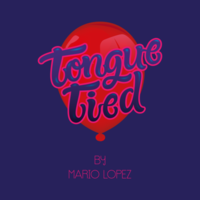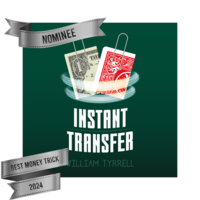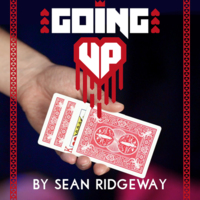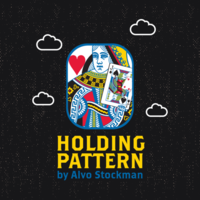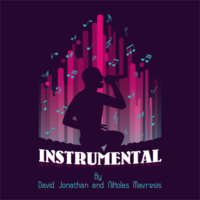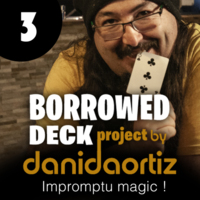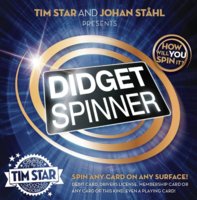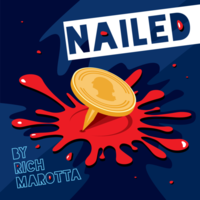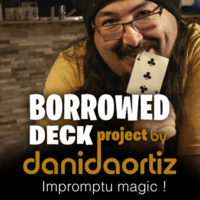A S.A.D Night in Hamburg by Looch (Instant Download)
Walk Around Mentalism - Lecture notes
| Price: | $25.00 |
In 2009, Looch was invited by the GEM to lecture at their annual convention in Hamburg, Germany. For the lecture, Looch prepared a very special set of lecture notes that covered a whole range of Walk Around Mentalism (WAM).
In these notes Looch discusses a wide range of topics and offers tips and advice plus several detailed unpublished effects from his repertoire. These lecture notes were initially only available to the GEM, but now after 5 years they are being made available to Penguin customers.
"I found the "thinking" process behind this routine to be wonderful. If you've been around mentalism for some time, after awhile you begin to de-emphasize the "methods" (eg. how tricks are done), and you really appreciate the subtleties, the nuances, and things like pacing ands routining of a mentalism act. That is what you have here. A really nicely routined act and solid thinking behind the process. Nice job Looch." Ben Cummings (Conversations with Mindreader's)
"If you do a fair amount of close-up mentalism, you'll enjoy the material here. Looch has acquired a good reputation for coming up with solid, powerful material and these lecture notes certainly showcase that." Jheff (Marketplace of the Mind)
*PDF Download
ASK HERE
Featured Magic Tricks
4 star 0%
3 star 0%
2 star 0%
1 star 0%

 Another amazing Looch production
Report this review
Another amazing Looch production
Report this review
Brilliant, straight forward mentalism. Not long winded presentations here, just mind reading as it should be.
And the thing about all of Looch's material is that it is so simple you can concentrate on the performance aspect of it.
Wish I could give it 6 stars.

 astonishingly simple yet intriguing
Report this review
astonishingly simple yet intriguing
Report this review
Even today I'm not sure if all colleagues attending could get completely what Looch presented. This is not because the ideas he shared were too sophisticated or something - quite the opposite.
Looch's "trademark" from my point of view is the straightness of his ideas. They are slim, straight to the point, in most cases astonishingly simple yet intriguing regarding their impact and versatility.
This is for actually all of his creations ... as far as I know them. And his ideas published in these lecture notes make no exception.
Definitively recommended!

 Highly recommended to anyone wanting to develop themselves as a close-up performer
Report this review
Highly recommended to anyone wanting to develop themselves as a close-up performer
Report this review

 A S.A.D. NIGHT IN HAMBURG BY LOOCH – A REVIEW
Report this review
A S.A.D. NIGHT IN HAMBURG BY LOOCH – A REVIEW
Report this review
Wayne Looch Bolsover is one of the most interesting young professionals in Mentalism. His specialty is walkaround gigs, and close-up mentalism, and in this field –which is not a mainstream one- he can claim to have a great experience, and a great level of insight. Looch is a nice and unassuming person, and in his books he shares with a great degree of simplicity what he thinks and what he does with his audiences. There is a great deal to learn from his thinking also if one does not do the same things –particularly in S.A.D. night in Hamburg, you’ll find –effects apart- a wealth of important advice about important *professional* aspects of the craft.
Attitude is everything –attitude coupled with habit. A professional is preceded not only by his name, but also immediately by the way he appears and behaves *before* doing anything. Attitude must become also a habit –to do things in an ordered manner, and not to leave anything important to chance. Which does not mean to be rigid –Looch’s approach is a ‘jazzing’ one, but instead means not to be shaggy in one’s basic way of framing things.
*****Structure and content*****
In these notes, there are many effects. Strong and workables ones. But the very great interest of the book lies mostly in the methodological notes, to which the main part of the pages are dedicated.
The first part is dedicated to the economic principle of ‘how to not’ become a packhorse –that is: to have on self only what will be needed for that occasion. It’s in itself a great lesson even if you don’t do what Looch does (as is my case, for instance): here you learn an attitude, which you can transfer onto your way of doing things.
There is then a very interesting discussion about how, and when (and if) to use one’s / borrowed / no / business cards in Mentalism (or whether one’s BC should be given more importance than that of a billet).
Many other tips follow, the most interesting being IMO an analysis about how to create logically ordered routines (a thing too often forgotten also by accomplished pros). Looch does not talk that much about narrative, but rather about congruency –in a very convincing way.
A praise for a visual approach to Mentalism follows, and a nice discussion about the concepts of chance and coincidence (and about how to milk on certain occasions). Then, there come the routines –very nice stuff, and very well explained.
Then, at pgs. 39-40 you will find another gem: Looch’s take on a much discussed topic, that of the mutual exclusivity or the possible mixing of the psychic and psychological approaches to Mentalism. And it’s two pages of pure food for thought.
*****Pros and cons of the book*****
No cons. Buy it, there is really a lot to learn from this chap. Professionalism in the first –then many other things.
Congrats and admiration, Wayne.
Until a sort while ago this e-book was only released to a small minority having been developed to support his lecture in Hamburg (hence the title). Even without Looch by your side to talk you through the forty eight pages of this work I found it a very pleasant read and one which was concise enough for even a novice performer to understand.
It is very obvious that this material is the result of countless real world performances for paying audiences. In short Looch has learned his craft the hard way and has documented his findings so that we can benefit from the fruits of his labor.
The main focal point of this work is to provide the reader with a working set template which will require very little pocket space and yet still play strong enough for the most challenging of audiences. The cliche packs small and plays big is certainly very apt here and 'm happy to report that this work delivers on both these counts
Looch opens with a discussion on the use of business cards in a mentalism. This provides a lot of food for thought and his insights offer new avenues of thought that would never have even crossed my mind. Topics here include how to hand out your business cards and how best to utilize them within performance.
Looch then details the select items (tools of the trade) that he carries upon his person for his walk around set. His revelations pertaining to the use of Post-it notes (with a nod to Julian (Bev) Moore) and his application of said items is fantastic. This routine is both fully illustrated and explained.
Any seasoned mentalist will agree that Mentalism by its very nature generally lacks the visual appeal that is so often found within its magic counterpart. This becomes important when the performer wishes to engage a larger crowd or draw an interest from other tables/guests. Looch offers some very practical methods and insights into how to make mentalism more visual and the techniques taught here are superb best of all these can easily be adapted to fit almost any routine you may be currently performing.
Next Looch discuses ideas for creating a working set which is flexible enough to be cut short due unforeseen events. Once again Looch displays a knowledge that can only be learned from experience, Looch even offers the reader a couple of example sets to help to clarify his point.
Next comes the meat of the material in which Looch walks us through one of his own personal sets. These including full patter, presentation and methodology. I can honestly say that this set contains some knockout material which includes:
Two spectators correctly intuiting a two digit number that you have written down in advance.
Reading the body language of several spectators to determine their names.
Predicting various choices that your spectator will make ahead of time.
Identifying and describing an unspoken memory that the spectator is concentrating on.
A realistic method for revealing the name of a selected card.
Despite having already received great value for may money I was further thrilled to read his thoughts on the "Spectator as mind reader" plot, how to choose your spectators, layering your methods for maximum impact, dealing with chance and coincidence and the e-book finally ends with an idea that is so devious even Sherlock Holmes wouldn't be able to fathom.
I'm sure you will have realized that I thoroughly enjoyed reading this work. It very much encapsulates Looches S.A.D (Simple and Direct) approach to mentalism and offers the reader a wide variety of insights into tried and tested methods for the close up mentalist.

 No brainer--just get it
Report this review
No brainer--just get it
Report this review
Watching Looch's Penguin Live lectures, you are struck by what a nice, unassuming guy he is. And as a teacher by trade, his instructional style is just about perfect--clear concepts, concisely explained. This is an excellent set of lecture notes, a must have.

Act Builder beta





